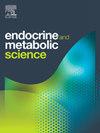Retrospective clinical analysis of time to recovery from diabetic ketoacidosis in Ethiopia
Q3 Medicine
引用次数: 0
Abstract
Background
Diabetes is a metabolic disorder that affected > or = 500 million people in 2021. Diabetic ketoacidosis is the most serious acute complication. Because of the significant health burden of diabetic ketoacidosis, we performed a retrospective study on the recovery time and predictors among adult diabetic mellitus patients in selected public hospitals in Southern Oromia in Ethiopia.
Methods
A retrospective follow-up study was conducted of 316 randomly selected adult diabetic ketoacidosis patients admitted between January 1, 2020, and July 31, 2023. A structured checklist was utilized. Data were entered into Epi-data version 4.6 and analyzed with STATA version 17, employing Kaplan-Meier survival curves, log-rank tests, and Cox-proportional hazards models to identify predictors. Results from bivariable and multivariable Cox-regression were reported via adjusted hazard ratio with 95 % confidence intervals.
Results
This study included 316 participants, with 256 adults (81.01 %) recovering throughout the follow-up period. The overall DKA recovery rate was 23.8 per 1000 person-hours (95 % CI: 22.21–27.07), and the median recovery time was 42 hr. Significant predictors of recovery time included random blood glucose level [AHR (95 % CI): 0.58 (0.38–0.90)], duration of diabetes mellitus [AHR (95 % CI): 0.24 (0.14–0.69)], and severity of DKA [AHR (95 % CI): 0.46 (0.16–0.84)].
Conclusion
The median DKA recovery time was prolonged, increasing the risk of complications. Blood glucose level, diabetes duration, and DKA severity were predictors of recovery time. Therefore, targeting these factors through research and interventions may improve outcomes and reduce DKA recovery duration.
埃塞俄比亚糖尿病酮症酸中毒患者康复时间的回顾性临床分析
背景:糖尿病是一种影响健康的代谢性疾病。到2021年,人口将达到5亿。糖尿病酮症酸中毒是最严重的急性并发症。由于糖尿病酮症酸中毒的重大健康负担,我们对埃塞俄比亚南奥罗米亚州选定公立医院的成年糖尿病患者的康复时间和预测因素进行了回顾性研究。方法对我院2020年1月1日至2023年7月31日收治的316例成人糖尿病酮症酸中毒患者进行回顾性随访研究。使用了一个结构化的检查表。将数据输入Epi-data版本4.6,并使用STATA版本17进行分析,采用Kaplan-Meier生存曲线、log-rank检验和cox -比例风险模型来识别预测因子。双变量和多变量cox回归的结果通过校正风险比报告,置信区间为95%。结果本研究包括316名参与者,其中256名成年人(81.01%)在随访期间康复。总体DKA恢复率为23.8 / 1000人小时(95% CI: 22.21-27.07),中位恢复时间为42小时。恢复时间的显著预测因子包括随机血糖水平[AHR (95% CI): 0.58(0.38-0.90)]、糖尿病病程[AHR (95% CI): 0.24(0.14-0.69)]、DKA严重程度[AHR (95% CI): 0.46(0.16-0.84)]。结论DKA中位恢复时间延长,并发症发生风险增加。血糖水平、糖尿病病程和DKA严重程度是恢复时间的预测因子。因此,针对这些因素,通过研究和干预可以改善结果,缩短DKA恢复时间。
本文章由计算机程序翻译,如有差异,请以英文原文为准。
求助全文
约1分钟内获得全文
求助全文
来源期刊

Endocrine and Metabolic Science
Medicine-Endocrinology, Diabetes and Metabolism
CiteScore
2.80
自引率
0.00%
发文量
4
审稿时长
84 days
 求助内容:
求助内容: 应助结果提醒方式:
应助结果提醒方式:


